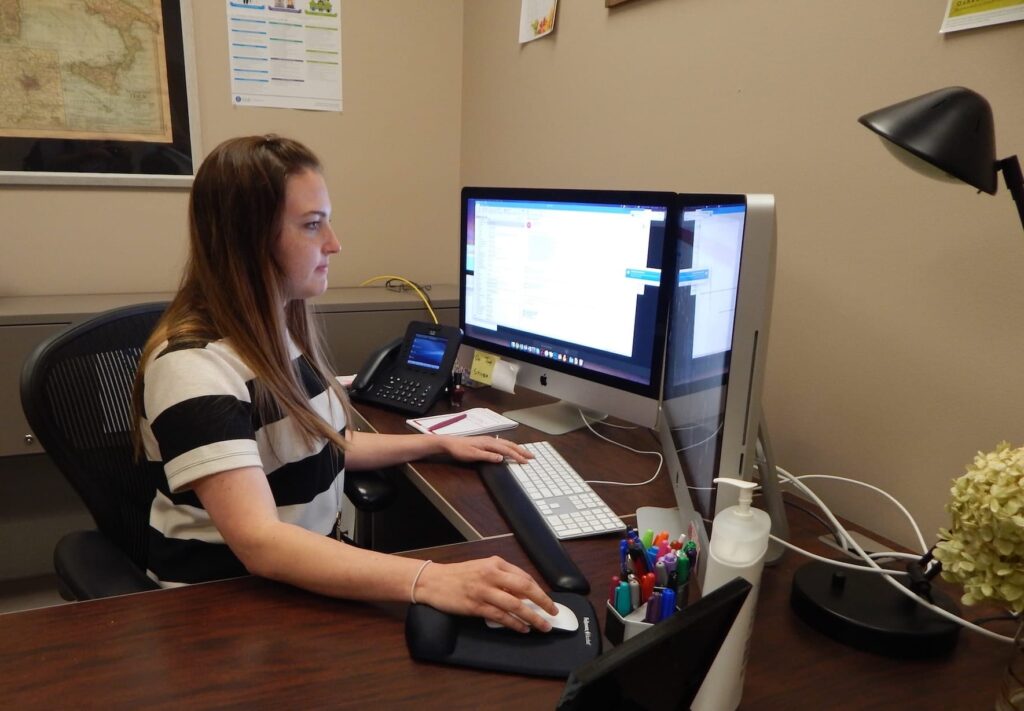Higher Education
Marketing & Creative, Project Management Office
How Western Kentucky University Took Control of their Projects

About Western Kentucky University
Western Kentucky University’s Division of Extended Learning and Outreach (DELO) supports 20,000+ students with lifelong learning and workforce training programs.
Primary Use Case
WKU’s DELO marketing team needed a centralized, scalable way to manage creative requests from across the university. Their goal was to streamline project intake, improve internal collaboration, and ensure every department had a clear and consistent way to request marketing support—without overwhelming the team or relying on chaotic email threads.
Previous Solutions
First, the team used a homegrown, customized task management solution that was reliant on email and on individuals to coordinate all of their projects.
Chose Workzone Over
Chose Workzone over a homegrown, email-based system that lacked structure and visibility. Then they adopted an enterprise-level platform that was too complex, hard to train on, and frustrating for both marketing and their internal clients.
They chose Workzone over both because it delivered the right mix of power and usability—flexible enough to manage complex work, but intuitive enough for everyone to get onboard fast.
The Situation
Requests from every department. Quick deadlines.
That was the situation for the marketing department of the Division of Extended Learning and Outreach (or affectionately called DELO) at Western Kentucky University. WKU is a public university with approximately 20,000 students.
This division is the outreach arm of the WKU. Through partnerships with faculty, academic departments, businesses and organizations, DELO offers a wide variety of for-credit and non-credit programs to students of all ages, interests and locations.

DELO has a seven-person marketing department which consists of a marketing manager, a market research/CRM coordinator and marketing specialists who oversee digital marketing and web/print design. They develop marketing for all DELO units and offices, ranging from online programs, dual credit and summer/winter to lifelong learning and workforce training.
“We function like an agency. We do everything from writing news releases and marketing content to developing print ads, posters, brochures, email campaigns and paid ads for digital marketing,” said Susan Esters, marketing manager for DELO.
Problems: Complexity, Trust, and Control
To keep up with all of those projects across numerous departments, the marketing team decided to try out project management software to help them manage requests.
First, the team used a homegrown, customized task management solution that was reliant on email and on individuals to coordinate all of their projects. There was also no record of the email communication.
Next, the whole division adopted one enterprise-level tool for use across all departments, including marketing.
But here’s how the team described that tool:
- Too big
- Complicated
- Hours of Training
- Really Expensive
- Not user friendly
- No vetting of new projects
“It was so complex. There was layer upon layer of information,” Susan said.
Other team members described having to fix project requests for others and that any and all requests, no matter if it fit the timeline or priorities, was automatically converted into a project, causing a lot of problems between the marketing department and the departments they serve.
“The system placed the burden on the clients to communicate their marketing needs,” said Anna Kerr, DELO marketing coordinator. “It created confusion, missed information and even some trust issues.”
Clients didn’t know the status of projects, how to enter them into the project management system or how long it would take to complete. Marketing didn’t feel like they were in control of their deadlines or deliverables. The clients were submitting marketing projects with no knowledge of what information was needed or how much work the marketing team needed to complete it.
“There was no confirmation. There were no forms. They aren’t marketing people. They shouldn’t have been expected to know all of our timelines. But in the old system, there was no way around it,” Susan said.
Every request was thrown against the wall, hoping to get done in a timeframe that may or may not have been fair to the team tasked with doing the actual work. Those trust issues started to take their toll.
“We talked about how frustrated we were about it,” Anna said. “It started to be every day that I had to find a project on someone’s computer because they couldn’t find a project where they had entered it.”

Action: Their Search and Choice
When their contract was up, they knew there had to be a better solution. One that would help them successfully manage their marketing projects, while also communicating more reliably and specifically with the departments they were trying to serve.
They knew how they wanted their team to function, with an emphasis on collaboration, but something that was easy to use. And a tool that would allow them to stay in control of their project management with crisp communication.
Those were the main benefits they were looking for, but it also had to have some key features:
- Email documentation and notifications
- Custom project request forms
- Ability to assign tasks
- Quick approvals
They already had experience with a complex tool – “It did way more than we needed it to,” Susan said—but they soon realized that smaller, task management options wouldn’t cut it without custom project request forms and approvals.
Instead, they chose Workzone—a project management software that’s easy to use, but with powerful features.
“Workzone was right in the middle, which is what we needed,” Anna said. “Workzone has worked so well for us, because it’s so flexible. It doesn’t make it complicated.”
Instead of days of training, the marketing team was up and running quickly in Workzone.
Easy Project Request Forms
They quickly saw the value in project request forms that they could customize themselves.
Easy-to-access forms without signing in – The marketing team set up different types of projects that their department heads could then fill out and request a project. This kept their clients out of the day-to-day of project management, but also kept communication inside of Workzone rather than by email.
Provide exact information – The forms ask the questions and details that the marketing team needs to get the job done. There’s no more guessing and not as much back and forth to figure out the exact requirements and needs. And the marketing team can change and update the forms if project needs change. This way they get all of the information they need right away before the project even begins.

Any time one of their clients has a project need, they start right here with the form. This is where everything in Workzone begins. The team then receives it, reviews it and then assigns it to the appropriate marketing team member for the next steps.
“For the most part, it’s pretty well-oiled. We started out with a really good list of forms and then we had to tweak them a little bit. If we kept having to request certain information, we just added it to the form. It’s been a work in progress, but it’s very rare. It works really well. We love it,” Susan said.
From the forms, the client or department can pick what type of project they need. The DELO marketing team has created forms for everything from a brochure to postcards to digital monitor ads and email campaigns.
See Workzone in Action
Simple project management software with real people ready to help you get started.
This also sparks new ideas for the type of deliverable that the team might use. For instance, one department may just request a postcard because that’s what they always do, but if they see an integrated paid social campaign as an option, they may reconsider their priorities.
“We rely on Workzone every day for managing all of our projects. We would be lost without it.” -Susan Esters
“It gives our teams new ideas, because they can choose from a list of things that our department offers. Without being prompted, they may not have even thought of them,” said Rhonda Gibbs, a marketing associate for DELO.
The request forms went a long way to improving how work got done for their clients.
Central Place of Communication
Besides fielding new requests, using Workzone also created a centralized place of communication where all of the records, comments, updates and approvals go.
“We send everything through Workzone,” said Rhonda. She reviews every project request and then assigns to the appropriate team member. “It records everything so wonderfully.”
Instead of communicating about projects and approvals via email or messaging apps, they can do it all in Workzone. That includes project files and any new changes. It’s been an adjustment, but a good one.
“We use Skype a lot as a marketing team, so I was in the habit of just Skyping someone or I would email them about projects. If I emailed them or Skyped them outside of Workzone, it wasn’t documented in one place. I’ve had to train myself to use Workzone to communicate about projects,” Susan said.

“Workzone really helped me to list out the email campaigns steps and double-check tasks,” Anna said.
Their Results
Increased Efficiency + 275% increase in email campaigns
Since implementing Workzone, the team’s workload has increased significantly. That both proved the need for Workzone, but also helped them complete projects even efficiently.
For example, Anna said that five years ago, she would send less than 80 email campaigns each year. That number has skyrocketed to almost 300. She can see the process and accountability that Workzone has brought to help manage that number. Without Workzone, she doesn’t think they could effectively coordinate 300 email campaigns.
“Workzone really helped me to list out the email campaigns steps and double-check tasks,” Anna said.
More Visibility and Collaboration
Another benefit is the increased communication and collaboration. It has allowed team members to see what others are working on, and chip in if needed or to pull images, copy or other assets from different projects to complete projects faster. It’s broken down their individual tunnel vision and silos.
One designer can pull ideas from another project, or the marketing coordinators can access images and drop those into a social or email campaign without having to request a whole new project or issuing another task.
“For most campaigns, there are multiple pieces that come together. It stops us from calling a meeting for every project or we would be meeting 24/7,” continued Susan.
Flexibility With a Strong Foundation
Perhaps most importantly, the marketing team has confidence in Workzone as a project management system. It has given them a solid foundation to manage increasing marketing requests, as well as new technology, demands and growth.
“Many people come to me and say, ‘This is what’s coming up so can you figure out a way to do it?’ So I need a practical application of how to implement it. I need Susan, the department and other team members to see the process written out. Workzone allows the flexibility for new project implementation with solid communication for all involved,” Anna says.
Susan says that Workzone helps her team work more cohesively with clients throughout DELO.
“We as a team are really good at what we do. We all play to our strengths. That’s really important, not only as part of a team, but to be efficient. In one fell swoop, Workzone allows us to see the big picture of everything that is going on.”
